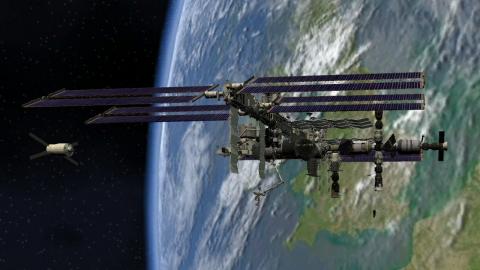ISS after 2020 Part 3

Initially it was thought that the ISS will not just be a research laboratory, but also orbital "plant" and a "launching pad" for other missions. Did not work, partly due to the fact that the complex did not reach the planned size. Instead of the 150 meters, he "grown" only to 109 years, which has resulted in a reduction of its capabilities by 27.6%.
The crew is also reduced: instead of eight station can only take seven people on a permanent basis. Do not be surprised that at the station are always only 6 cosmonauts/astronauts. This number is limited by total number of seats in the two rescue "lifeboats", docked to the ISS. If CST 100 or Dragon will have time to enter into operation before 2020 year, then maybe the more complex and work the main crew of seven people.
Despite the fact that the MKS flew in orbit for more than 15 years without any serious problems, this does not mean that the risk of near earth missions became less. NASA estimated the risk of collision of station with space debris during any 6 month period of time, as 1:42 (remember the movie "gravity").
Moreover, we are talking about the incident, which will lead to the loss of integrity of the complex. If evenly distributed the probability of this event is for the entire service life of the ISS until 2020, the year, you get 1:4. For comparison, the odds in modern civil aviation on the incident with the death of the passenger is estimated as 1 to 3.5 5 million flights.
But this is not important
The high cost, risk, technical failures all of this could be acceptable, if ISS were performed at full capacity its primary role of a research laboratory. But with this and there are major problems.
As noted in the report, "the future success of the stations as research facilities largely depends on the ability of the "Center for advanced space studies" (CASIS), which manages and not related to NASA research on the ISS us segment, referred to as the "national laboratory, USA" there would be sufficient interest from private users and investors, and to attract the necessary funding on their part".
But with this and there's a problem, because to date, CASIS really was able to collect only $550. At the same time he was promised investment from various sources in the amount of 8.2 million, while promises remain. Therefore, the main source of funding CASIS remains of NASA, the organization's revenue generating $15 million annually.
One of the reasons why private investors are reluctant to invest in CASIS, is that unclear question with intellectual and technological property, created on Board the ISS with the help of private investment. In an effort to remedy the situation of NASA, in 2013 to year introduced in Congress a bill providing for the preservation of private researchers "of all rights in inventions made during the operation of the ISS". However, while the bill was never put to any vote on Capitol hill.
Thus, the "drive" of the ISS in orbit is expensive, and every year will become even more expensive. Only in 2013, NASA has spent on the station for $2.9 billion, or approximately 17.2 per cent from its annual budget with a volume of 16.9 billion. Thus the continued development of new launch vehicle the SLS have gone 1.4 billion, and the new ship Orion 1.1 billion dollars.
Thus, the MCS largely financial, depletes the work on the development of advanced equipment for research and exploration of deep space.
But that's not all. According to estimates, "the inspector General's office", the budget request of the President for 2015, which contains a five year forecast of maintenance costs of the complex, on the 614 million dollars less than need really. It happened because of underestimation of the cost of cargo and manned flights "private" space ships.
As for science, that of the total amount that is spent annually on the ISS, only 10% goes to research. 77% eat maintain the complex in a healthy state, as well as delivery of cargo and crew on Board.
In addition, as emphasized by the authors of the report, "a significant amount of research aboard the ISS is connected with search of ways to reduce risks for crews during long duration space flights. However, the Agency will not be able to find all the required methods, even if the station will fly until 2024".
Hence the General conclusion that the main function of the ISS is to be a space "simulator". But this machine is quite expensive and also unsafe to those who are directly working on it.
This conclusion may lead NASA to another conclusion: maybe we should stop spending money on the ISS after 2020, the year by redirecting them to the early establishment of the technology for manned flights into deep space the more that astronauts beyond near earth space, at least not threatened by space debris, representing the main danger for the inhabitants of the ISS.